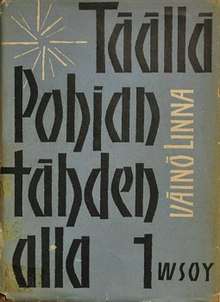Under the North Star trilogy
Under the North Star (Finnish: Täällä Pohjantähden alla) is a trilogy published between 1959–1962 by Finnish author Väinö Linna. The novel follows the life of a Finnish family from 1880, through the First World War, the Finnish Civil War and the Second World War, to about 1950. Through the lives of ordinary people, it describes the clash of ideals in Finland's language strife and the struggle between the Whites (nationalists) and the Reds (socialists) in the movement to Independence and Civil War.
 First edition of first book in trilogy | |
Under the North Star The Uprising Reconciliation | |
| Author | Väinö Linna |
|---|---|
| Original title | Täällä Pohjantähden alla |
| Translator | Richard Impola |
| Country | Finland |
| Language | Finnish |
| Publisher | WSOY |
| Published | 1959 1960 1962 |
| Published in English | 2001–2003 |
| No. of books | 3 |
The novel shares one main character, Vilho Koskela, and covers some of the same events as another novel: The Unknown Soldier by the author.
Plot summary
The story opens with Jussi, a farm hand from Häme, clearing marshland to create a croft, which will later be called Koskela. In the first part of the book tension mounts between crofters and land owners. Jussi's son Akseli becomes an active socialist. At the same time the upper classes are concerned with language strife and Finland's relationship with Russia.
In the second part the Finnish Civil War breaks out. The book describes the atrocities committed on both sides, as well as the tensions which lead up to them. The war hits Koskela harshly, for the family loses two sons.
In the third part the community is dominated by the whites, the victors of the Civil War. In Koskela, however, matters improve as crofters are liberated and Koskela becomes an independent farm. Things turn for the worse at the outbreak of the Second World War. Again Koskela pays a heavy price, losing three sons. The last chapters of the book concentrate on the reconciliatory atmosphere created by the joint hardships endured during the war.
Main characters
- Akseli Koskela, platoon leader in the Red Guard, later a farmer
- Elina Koskela, Akseli's wife
- Jussi Koskela, Akseli's father, tenant of the vicarage
- Alma Koskela, Akseli's mother and Jussi's wife
- Aleksi Koskela, Akseli's brother, Jussi and Alma's second son
- August Koskela, Akseli and Aleksi's brother, Jussi and Alma's third son. (Aku for short)
- Adolf Halme, village tailor
- Lauri Salpakari, the local vicar and landlord of the Koskela Family
- Ellen Salpakari, Vicar Salpakari's wife, a conservative politician
- Otto Kivivuori, tenant farmer, Elina's father
- Anna Kivivuori, Otto's wife, Elina's mother
- Janne Kivivuori, Otto and Anna's eldest son, mason, socialist politician
- Oskari Kivivuori, Otto and Anna's youngest son, member of the Red Guard (Osku for short)
- Anttoo Laurila, tenant farmer
- Uuno Laurila, Anttoo's son, member of the Red Guard
- Elma Laurila, Anttoo's daughter, Akusti's fiancée
- Kalle Töyry, master of the Töyry House, landlord of the Laurila Family
- Artturi Yllö, judge and wealthy landowner
- Antero Mellola, very fat saw-mill owner
- Preeti Leppänen, tenant farmer
- Aune Leppänen, Preeti's daughter
- The Baron, owner of the Manor, landlord of the Leppänen Family
- The Baroness, The Baron's wife
- The Wolf-Kustaa, hunter and tramp
Impact
The book is considered a classic in Finland with print runs into hundreds of thousands. Even most of those who have not read the book are familiar with the iconic opening words "Alussa olivat suo, kuokka — ja Jussi" ("In the beginning there were the marsh, the hoe — and Jussi").
The second book in the trilogy, The Uprising, generated considerable controversy over its portrayal of the Finnish Civil War because, for the first time, a novel was published that was sympathetic (in human terms, if not politically) towards the Reds. Up until then, all history of the Finnish Civil War had been written by the Whites. Under the North Star played a crucial role in starting a discussion in Finland over what really happened in 1918 and in healing decades-old wounds between the two factions.
Translations
Under the North Star has been translated into English by Richard Impola:
- Vol. 1 Under the North Star pub. 2001, ISBN 0-9685881-6-6
- Vol. 2 Under the North Star 2: The Uprising pub. 2002, ISBN 0-9685881-7-4
- Vol. 3 Under the North Star 3: Reconciliation pub. 2003, ISBN 0-9685881-8-2
Unfortunately these translated publications contain many typographical errors.[1]
See also
Footnotes
- See, e.g., Under the North Star 2: The Uprising at p. 27, where "realization" is rendered as "realizationπ"; see also p. 412., where a sentence is repeated verbatim, clearly erroneously. Elsewhere, an asterisk appears although there are no notes to the translation. Other minor errors, such as random periods and white space formatting errors, are present throughout.
External links
| Wikiquote has quotations related to: Under the North Star trilogy |
- The Finnish Civil War as Depicted in Väinö Linna's Under the North Star
- Biography of Väinö Linna on: 100 Faces from Finland – a Biographical Kaleidoscope (retrieved: January 2013)
- Books translated into English by Finnish American Translators Associasion (FATA)